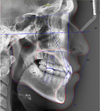|
|
| 1. |
Orthlieb JD, Laurent M, Laplanche O. Cephalometric estimation of vertical dimension of occlusion. J Oral Rehabil 2000;27:802–807.
|
|
| 2. |
Turner KA, Missirlian DM. Restoration of the extremely worn dentition. J Prosthet Dent 1984;52:467–474.
|
|
| 3. |
Burstone CR. Deep overbite correction by intrusion. Am J Orthod 1977;72:1–22.
|
|
| 4. |
Park YC, Lee SY, Kim DH, Jee SH. Intrusion of posterior teeth using mini-screw implants. Am J Orthod Dentofacial Orthop 2003;123:690–694.
|
|
| 5. |
Ramfjord SP, Blankenship JR. Increased occlusal vertical dimension in adult monkeys. J Prosthet Dent 1981;45:74–83.
|
|
| 6. |
Berry DC, Poole DF. Attrition: possible mechanisms of compensation. J Oral Rehabil 1976;3:201–206.
|
|
| 7. |
Crothers A, Sandham A. Vertical height differences in subjects with severe dental wear. Eur J Orthod 1993;15:519–525.
|
|
| 8. |
Varrela TM, Paunio K, Wouters FR, Tiekso J, Söder PO. The relation between tooth eruption and alveolar crest height in a human skeletal sample. Arch Oral Biol 1995;40:175–180.
|
|
| 9. |
Dahl BL, Krogstad O. The effect of a partial bite-raising splint on the inclination of upper and lower front teeth. Acta Odontol Scand 1983;41:311–314.
|
|
| 10. |
Mohindra NK, Bulman JS. The effect of increasing vertical dimension of occlusion on facial aesthetics. Br Dent J 2002;192:164–168.
|
|
| 11. |
Albarakati SF, Kula KS, Ghoneima AA. The reliability and reproducibility of cephalometric measurements: a comparison of conventional and digital methods. Dentomaxillofac Radiol 2012;41:11–17.
|
|
| 12. |
Chung KR. In: The result report about measurement of lateral cephalogram in Korean adult who have normal occlusion. Seoul, Rep. of Korea: Korean Assoc Orthodont; 1997. pp. 13-17.
|
|
| 13. |
Broadbent BH. A new x-ray technique and its application to orthodontia. Angle Orthod 1931;1:45–66.
|
|
| 14. |
Ricketts RM. The role of cephalometrics in prosthetic diagnosis. J Prosthet Dent 1956;6:488–503.
|
|
| 15. |
DiPietro GJ, Moergeli JR. Significance of the Frankfortmandibular plane angle to prosthodontics. J Prosthet Dent 1976;36:624–635.
|
|
| 16. |
McGEE GF. Use of facial measurements in determining vertical dimension. J Am Dent Assoc 1947;35:342–350.
|
|
| 17. |
Ellinger CW. Radiographic study of oral structures and their relation to anterior tooth position. J Prosthet Dent 1968;19:36–45.
|
|
| 18. |
Fayz F, Eslami A. Determination of occlusal vertical dimension: a literature review. J Prosthet Dent 1988;59:321–323.
|
|
| 19. |
Carlsson GE, Ingervall B, Kocak G. Effect of increasing vertical dimension on the masticatory system in subjects with natural teeth. J Prosthet Dent 1979;41:284–289.
|
|
| 20. |
Rebibo M, Darmouni L, Jouvin J, Orthlieb JD. Vertical dimension of occlusion: the keys to decision. Int J stomatol occlu med 2009;2:147–159.
|
|
| 21. |
Scheideman GB, Bell WH, Legan HL, Finn RA, Reisch JS. Cephalometric analysis of dentofacial normals. Am J Orthod 1980;78:404–420.
|
|
| 22. |
Mack MR. Vertical dimension: A dynamic concept based on facial form and oropharyngeal function. J Prosthet Dent 1991;66:478–485.
|
|
| 23. |
Parker CD, Nanda RS, Currier GF. Skeletal and dental changes associated with the treatment of deep bite malocclusion. Am J Orthod Dentofacial Orthop 1995;107:382–393.
|
|
| 24. |
Geelen W, Wenzel A, Gotfredsen E, Kruger M, Hansson LG. Reproducibility of cephalometric landmarks on conventional film, hardcopy, and monitor-displayed images obtained by the storage phosphor technique. Eur J Orthod 1998;20:331–340.
|
|
| 25. |
Yoon YJ, Kim KS, Hwang MS, Kim HJ, Choi EH, Kim KW. Effect of head rotation on lateral cephalometric radiographs. Angle Orthod 2001;71:396–403.
|
|
| 26. |
Lauritzen AG, Bodner GH. Variations in location of arbitrary and true hinge axis points. J Prosthet Dent 1961;11:224–229.
|
|




 PDF
PDF ePub
ePub Citation
Citation Print
Print










